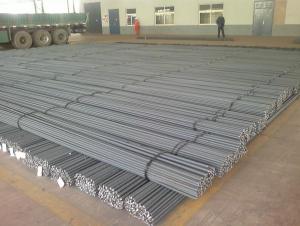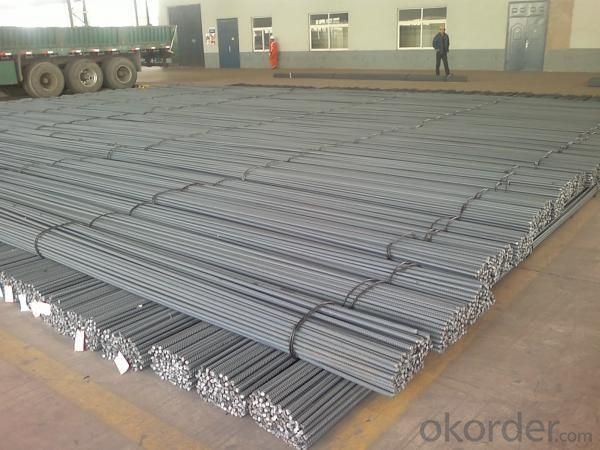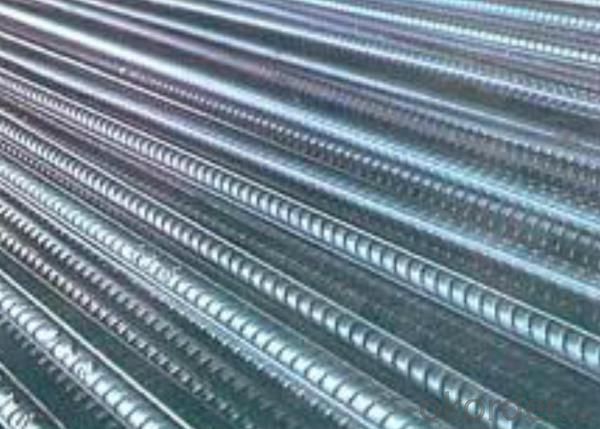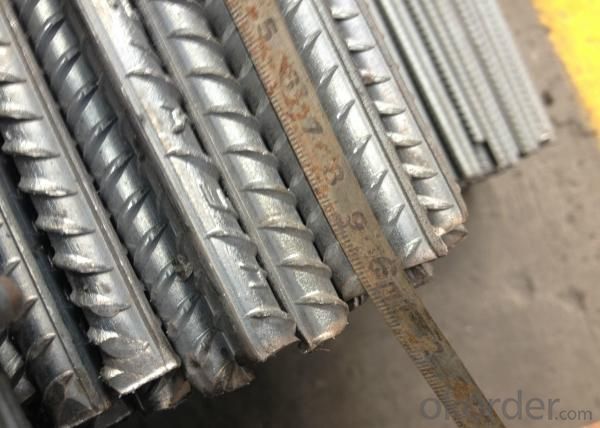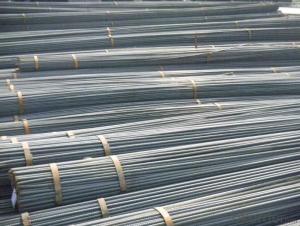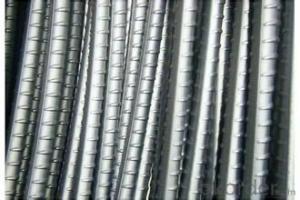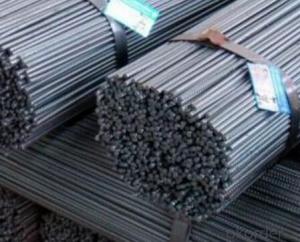Deformed Steel Bar
- Loading Port:
- China Main Port
- Payment Terms:
- TT or LC
- Min Order Qty:
- 25MT m.t.
- Supply Capability:
- 800000 MT/YEAR m.t./month
OKorder Service Pledge
OKorder Financial Service
You Might Also Like
Specifications of Deformed Steel Bar:
Standard | GB | HRB335, HRB400, HRB500 | |
UK | G460B, B500A, B500B,B500C | ||
USA | GR40, GR60 | ||
Diameter | 6mm,8mm,10mm,12mm,14mm,16mm,18mm,20mm, 22mm,25mm,28mm,32mm,36mm,40mm,50mm | ||
Length | 6M, 9M,12M or as required | ||
Place of origin | Hebei, China mainland | ||
Application | building,construction,road,bridge etc | ||
Brand name | DRAGON | ||
Theoretical weight and section area of each diameter as below for your information:
Diameter(mm) | Section area (mm²) | Mass(kg/m) |
6 | 28.27 | 0.222 |
8 | 50.27 | 0.395 |
10 | 78.54 | 0.617 |
12 | 113.1 | 0.888 |
14 | 153.9 | 1.21 |
16 | 201.1 | 1.58 |
18 | 254.5 | 2.00 |
20 | 314.2 | 2.47 |
22 | 380.1 | 2.98 |
25 | 490.9 | 3.85 |
28 | 615.8 | 4.83 |
32 | 804.2 | 6.31 |
36 | 1018 | 7.99 |
40 | 1257 | 9.87 |
50 | 1964 | 15.42 |
Usage and Applications of Deformed Steel Bar:
Deformed bar is widely used in buildings, bridges, roads and other engineering construction. Big to highways, railways, bridges, culverts, tunnels, public facilities such as flood control, dam, small to housing construction, beam, column, wall and the foundation of the plate, deformed bar is an integral structure material. With the development of world economy and the vigorous development of infrastructure construction, real estate, the demand for deformed bar will be larger and larger..
Packaging & Delivery of Deformed Steel Bar:
Packaging Detail: products are packed in bundle and then shipped by container or bulk vessel, deformed bar is usually naked strapping delivery, when storing, please pay attention to moisture proof. The performance of rust will produce adverse effect.
Each bundle weight: 2-3MT, or as required
Payment term: TT or L/C
Delivery Detail: within 45 days after received advanced payment or LC.
Label: to be specified by customer, generally, each bundle has 1-2 labels
Trade terms: FOB, CFR, CIF
Deformed Steel Bar in Coil
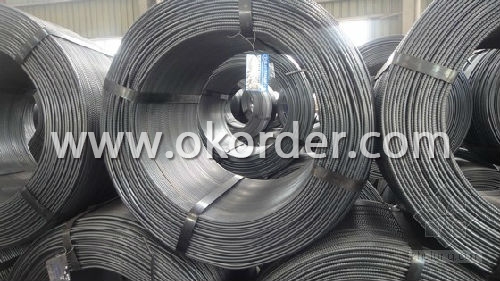
Produce Line of Deformed Steel Bar
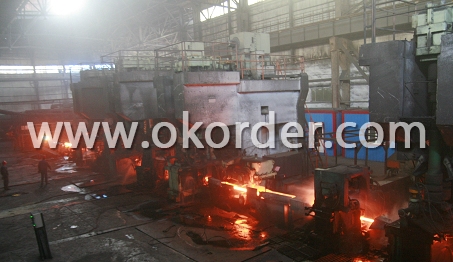
Note:
1. Our products are produced according to national standard (GB), if not, supply according to national standards (GB) or agreement as customer required.
2. Other Grade and Standard Deformed Steel Bar we can supply:
Grade: GR40/GR60, G460B/B500A/B500B/B500C,BST500S
Standard: ASTM, BS, DIN
The Minimum Order Quantity of these products is high, and need to be confirmed.
3. We can not only supply Deformed Steel Bar; if you need anything about building materials, please contact us for further information.
4. Please send us your detail specifications when inquire. We will reply to you as soon as possible. We sincerely hope we can establish a long stable business relationship.
- Q: What are the factors considered in designing with steel rebars?
- Some of the factors considered in designing with steel rebars include the structural requirements of the project, including the load that the rebars will need to support and the overall design and layout of the structure. Other factors include the type and grade of steel being used, the corrosion resistance properties, the spacing and arrangement of the rebars, and the connection details between the rebars and other structural elements. Additionally, factors such as construction techniques, budgetary constraints, and local building codes and regulations also influence the design considerations for steel rebars.
- Q: How can corrosion of steel rebars be prevented?
- Corrosion of steel rebars can be prevented through various methods such as applying protective coatings, using corrosion-resistant alloys, ensuring proper concrete cover, maintaining an effective drainage system, and implementing cathodic protection techniques. Regular inspections, proper maintenance, and prompt repairs also play a crucial role in preventing corrosion of steel rebars.
- Q: How are steel rebars stored and handled on construction sites?
- Steel rebars are typically stored in designated areas on construction sites to ensure easy access and organization. They are often stacked horizontally and secured with supports to prevent them from rolling or falling. When handling rebars, workers wear appropriate protective gear and use equipment such as cranes or forklifts to lift and move them safely. Additionally, rebars are carefully inspected for any defects or damages before being used in construction projects.
- Q: How are steel rebars connected or joined together during construction?
- Steel rebars are typically connected or joined together during construction by overlapping the ends of the rebars and tying them using steel wire or using mechanical couplers.
- Q: Can steel rebars be used in composite structures?
- Yes, steel rebars can be used in composite structures. Steel rebars are commonly used as reinforcing elements in concrete structures, but they can also be utilized in composite structures by integrating them with other materials such as fiberglass, carbon fiber, or polymers. This combination enhances the overall strength, durability, and load-bearing capacity of the composite structure.
- Q: What is the maximum allowable spacing between steel rebars in columns?
- The maximum allowable spacing between steel rebars in columns is typically specified by building codes and design standards, which may vary depending on the specific project and location. However, as a general guideline, the maximum spacing between rebars in columns is commonly recommended to be no more than three times the diameter of the largest bar or 18 inches (whichever is smaller). This helps ensure proper reinforcement and structural integrity of the column.
- Q: Are there any alternatives to steel rebars?
- Yes, there are several alternatives to steel rebars. One alternative is the use of fiber-reinforced polymer (FRP) rebars, which are made of high-strength fibers embedded in a polymer matrix. FRP rebars offer several advantages over traditional steel rebars, including corrosion resistance, high tensile strength, and lightweight properties. They are also non-magnetic and electrically non-conductive, making them suitable for areas with electromagnetic interference concerns. Another alternative is the use of basalt rebars, which are made from basalt rock fibers. Basalt rebars offer similar benefits as FRP rebars, including corrosion resistance and high tensile strength. Additionally, some manufacturers have developed alternative materials such as bamboo, carbon fiber, and glass fiber rebars, which have also shown promise in certain applications. However, it is important to note that the choice of alternative rebars depends on the specific requirements of a project, and factors such as cost, availability, and local building codes should be considered when selecting an alternative to steel rebars.
- Q: Are there any alternatives to steel rebars for reinforcement?
- Yes, there are several alternatives to steel rebars for reinforcement. Some commonly used alternatives include fiberglass rebars, carbon fiber reinforced polymers (CFRP), glass fiber reinforced polymers (GFRP), and basalt rebars. These materials offer advantages such as high tensile strength, corrosion resistance, and lighter weight compared to steel rebars. However, the choice of reinforcement material depends on various factors such as project requirements, cost-effectiveness, and specific structural needs.
- Q: Can steel rebars be used in buildings with high architectural requirements?
- Yes, steel rebars can be used in buildings with high architectural requirements. Steel rebars provide the necessary strength and structural integrity required for such buildings, while also allowing for flexibility in design and construction. They can be easily shaped and bent to meet specific architectural demands, ensuring both functionality and aesthetic appeal in the building's design.
- Q: How are steel rebars used in the construction of oil and gas refineries?
- The strength and durability of steel rebars make them widely used in the construction of oil and gas refineries. These rebars, made from high-strength steel, reinforce concrete structures and increase their load-bearing capacity. In the construction of oil and gas refineries, steel rebars are primarily utilized in various reinforced concrete structures like foundations, columns, beams, slabs, and walls. These structures are crucial for supporting heavy equipment, storage tanks, processing units, and other essential refinery components. During construction, rebars are embedded in the concrete, forming a reinforced framework that can withstand high loads, seismic activity, and extreme weather conditions. The steel reinforcement enhances the concrete's tensile strength, making it more resistant to cracks and structural failure. Furthermore, the use of rebars ensures the long-lasting nature of refinery infrastructure. Oil and gas refineries operate in harsh environments with exposure to chemicals, high temperatures, and corrosive agents. Steel rebars possess excellent corrosion resistance, which is vital for maintaining the structural integrity of the refinery. Moreover, rebars facilitate the construction of complex shapes and configurations required in refinery structures. They can be bent, cut, and molded to fit specific design requirements, enabling the creation of intricate concrete structures essential for the refinery's functionality. Overall, steel rebars play a vital role in oil and gas refinery construction, providing necessary reinforcement to concrete structures. Their strength, durability, and corrosion resistance make them ideal for enduring the demanding conditions in these facilities, ensuring the safety and longevity of the refinery infrastructure.
1. Manufacturer Overview
| Location | Hebei, China |
| Year Established | 2002 |
| Annual Output Value | Above US$ 400 Million |
| Main Markets | South Asia; Middle East;Southeast Aisa |
| Company Certifications |
2. Manufacturer Certificates
| a) Certification Name | |
| Range | |
| Reference | |
| Validity Period |
3. Manufacturer Capability
| a) Trade Capacity | |
| Nearest Port | Tianjin |
| Export Percentage | 60%-80% |
| No.of Employees in Trade Department | 11-20 People |
| Language Spoken: | English; Chinese |
| b) Factory Information | |
| Factory Size: | Above 100,000 square meters |
| No. of Production Lines | 2 |
| Contract Manufacturing | OEM service offered |
| Product Price Range | average |
Send your message to us
Deformed Steel Bar
- Loading Port:
- China Main Port
- Payment Terms:
- TT or LC
- Min Order Qty:
- 25MT m.t.
- Supply Capability:
- 800000 MT/YEAR m.t./month
OKorder Service Pledge
OKorder Financial Service
Similar products
Hot products
Hot Searches
Related keywords
